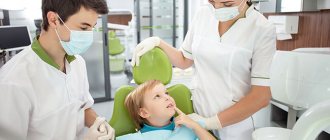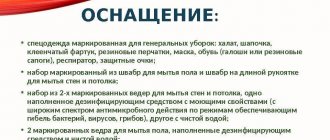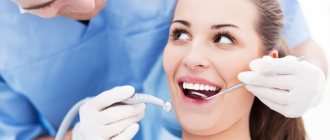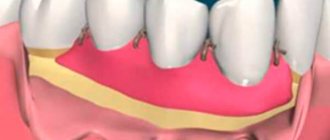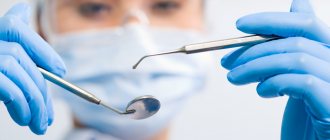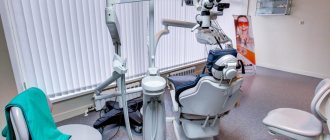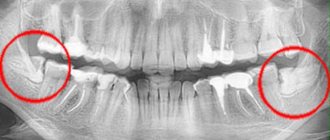In dentistry, the practice of working with four hands is the most popular and convenient format for interaction between a doctor and his assistant, therefore, in clinics engaged in this area, recruitment agencies try to recruit experienced and reliable employees not only for the position of doctors, but also for vacancies of junior medical staff. What are the responsibilities of a dental assistant, what does he do in the workplace, what rights does he have and what is the scope of his responsibility - comprehensive information in the article.
What kind of profession is a dental assistant?
A dental assistant is the right hand of any dentist. Without him, no clinic will be able to function normally, since he performs all the preparatory work in the doctor’s office, helps him at appointments, and maintains documentation. The remaining responsibilities of a dental assistant are determined by his immediate superiors - the doctor and the head of the clinic (department). Typically, these specialists provide paramedical care without interfering in the treatment process, but sometimes doctors delegate some of their own powers, instructing an assistant to perform an initial examination of the patient or carry out simple manipulations with him.
This profession is quite in demand in the labor market, because there are a lot of offices providing dental and oral cavity treatment services in our country. The responsibilities of a dental assistant in a private clinic may differ from those performed by a specialist in a budget organization. Firstly, because in each institution the doctor works with materials familiar to him and using a certain technology, and secondly, because doctors in private practice, as a rule, have more modern equipment, they modernize patient management protocols and respond faster to innovations in your field of activity.
Disinfection of gloves
The assistant disinfects:
- your gloves and the doctor’s gloves before starting the treatment;
- the doctor's gloves every time during the appointment, after he touched the lamp, chair, medical card, picture and other objects.
The procedure for disinfecting gloves in the patient’s field of view:
- the doctor presents his gloved hands folded in the shape of a boat,
- the assistant treats the doctor’s gloves with a disinfectant spray,
- the assistant processes his gloves.
Typical shortcomings and errors in the aspect of “Disinfection of gloves”
Assistant:
- disinfects gloves out of sight of the patient;
- disinfects gloves by spraying the spray on the patient’s face;
- delays in processing gloves, forcing the doctor to disinfect his gloves himself.
Doctor:
- without waiting for an assistant, he disinfects his gloves himself;
- presents an outstretched arm with a vertically raised palm for processing;
- based on the patient, does not ask the assistant to disinfect gloves after touching anything;
- touching something, disinfects gloves out of sight of the patient or without voicing this action to the patient.
Dental Assistant Education
In order to work as a dental assistant, you must have a secondary specialized medical education. At the same time, for some clinics it is important that the candidate graduate from any medical college with a specialty in “Nursing,” while others fundamentally require a diploma in the specialty “Preventive Dentistry.”
In addition to a diploma confirming a level of knowledge sufficient for work, the assistant must promptly obtain a state specialist certificate. Let us remind you that according to the law, employers and regulatory authorities do not have the right to demand this document from graduates of educational institutions if they completed their studies less than five years ago. A specialist certificate is not just another piece of paper, but a serious certification document that guarantees that a candidate for a vacant position in a clinic will be able to perform the duties of a dental assistant. The certificate confirms that the health worker has sufficient theoretical and practical skills.
4-hand operation
In advertisements for dental assistant searches, the authors tend to often indicate that the candidate must have sufficient skills and qualifications to work with a doctor four-handed. What does this mean? The doctor is forced to perform all dental procedures quite quickly: many filling materials, as well as medications, must be removed from the packaging as soon as possible and used for their intended purpose. At the same time, it is important to follow the stages of work, not to confuse anything. Sometimes the work requires illuminating the area of dental reconstruction with a special lamp, which the doctor himself cannot do. Also, the doctor often needs a quick change of working tools, attachments on drills, mirrors, and forceps. It is to quickly perform all these tasks that a dental assistant is required. The assistant’s responsibilities are to always be within the doctor’s reach, quickly respond to his requests and know the sequence of his main actions in order to be able to predict the boss’s “order.”
If the tandem is successful, and the doctor and his assistant understand each other perfectly, then their productivity increases significantly. That’s why clinics encourage working with 4 hands. The duties of a dental assistant do not require a person to show excessive initiative; on the contrary, it is important that the assistant maintain business and personal subordination with the doctor, be diligent, attentive and responsible.
Peri-medical activities of a dental assistant
The range of responsibilities assigned to a dental assistant depends greatly on the doctor himself, as well as the services he provides. Thus, general practitioners who deal with surgical and therapeutic manipulations, prosthetics, orthodontics and orthopedics have more stringent requirements for assistants. The responsibilities of dental assistants also differ due to the fact that they may be involved in the treatment process to varying degrees. Paramedical care consists of performing the following types of work:
- compliance with sanitary standards in the office, timely disinfection, weekly general cleaning (washing floors, walls, ceilings, windows, furniture and equipment);
- preparing instruments for use, disinfecting them, sterilizing them;
- cleaning the doctor’s workplace at the end of the working day, including disinfection of handpieces, turning off equipment;
- keeping records of medications, consumables and dressings, issuing them to the doctor, monitoring expiration dates and leftovers;
- maintaining documentation, registering patients, filling out various reporting forms, making entries in journals on cleaning, serviceability of equipment, sterilization of instruments.
And, of course, the main responsibilities of a dental assistant are to quickly carry out the doctor’s orders during work, meet patients at the reception desk and escort them to their chair.
Functions of a dental nurse
The functional responsibilities of a nurse in dentistry are specified in the employment contract. In accordance with the provisions of the document, the employee must perform the following tasks:
- Adhere to sanitary and epidemiological norms and rules.
- Work in accordance with the documentation regulating the activities of the nurse in the dental office.
- Follow the internal routine.
- Prepare patients for upcoming treatment, sedation and anesthesia.
- Carry out instructions from immediate superiors.
- Advise patients on the prevention of dental diseases.
- Promote a healthy lifestyle and implement preventive measures.
- Carry out nursing procedures in the established sequence.
- Follow the rules for working with dental equipment, instruments, and materials.
- Provide emergency assistance and call a doctor.
- Immediately inform management about equipment malfunctions and possible danger to the life and health of employees and visitors.
Assistant with partial physician responsibilities
In many clinics, assistants are also responsible for conducting diagnostic procedures, which means they must be able to work with a visiograph and x-ray machine, using them to take targeted, intraoral and panoramic photographs.
If the assistant has a fairly good theoretical and practical knowledge base, the doctor can trust him to perform more complex tasks. In addition to all of the above, the following responsibilities will be assigned to his shoulders:
- initial examination of the patient;
- partial implementation of preventive, therapeutic and diagnostic procedures;
- assistance in selecting filling material;
- maintaining cleanliness in the patient’s mouth while the doctor is working (removing saliva, blood, rinsing the mouth).
Filling out the patient chart is also the responsibility of the dental assistant. What should he indicate there? The name of the patient, his address, date of birth and age, the amount of work the doctor did, his instructions.
Light adjustment
Assistant:
- directs the light of the lamp so that it directly illuminates the area in the patient’s oral cavity required for examination or treatment;
- sets the lighting differently for each jaw: when working on the lower jaw, the light is directed straight down; when working on the upper jaw, the light should be directed at an angle;
- makes sure that the light does not shine in the patient’s eyes;
- promptly turns on, turns off and adjusts the brightness of the lamp depending on the stage of treatment (for example, when selecting burs or working with light-curing materials, the lamp light should be dimmed).
Notes:
- the assistant should be able to reorient or turn off the lamp at any time, so it should be at a distance no further than his outstretched arm;
- The assistant turns off the lamp light in the following cases:
- every time a doctor talks with a patient, discussing a treatment plan (prosthetics), giving recommendations, making a prognosis;
- when determining the color of a future restoration or prosthesis, when natural lighting is needed.
Typical shortcomings and errors in the “Light adjustment” aspect
Assistant:
- incorrectly sets the light of the installation lamp - the area of the surgical field is not illuminated or is not illuminated enough;
- does not dim the brightness of the lamp when working with light-curing materials in the patient’s oral cavity;
- does not turn off the lamp light when it is possible to give the patient a rest (for example, when changing the bur).
Doctor:
- adjusts the light of the lamp independently, not trusting the assistant to do this or anticipating his actions when he is slow.
Job Description for Dental Assistant
Each clinic develops its own job description for employees. According to this document, the nuances of the employees’ work are determined: rights, areas of responsibility, duties and requirements. A dental assistant is a serious position, so the instructions for him must include the following mandatory points:
- General provisions (education, work experience, additional skills and abilities; clarification of the service hierarchy; legislative standards required in the work; the acting assistant is indicated in the event of his absence).
- Job responsibilities - a list of tasks that the assistant will need to perform.
- Employee rights.
- The responsibility he bears to the clinic and patients.
The job description must be signed by both the head of the clinic and the subordinate. The document is marked with the date of its creation. In this case, one copy remains in the clinic, and the other is given to the dental assistant.
What knowledge should a dental nurse have?
First of all, in order to competently perform his duties, a specialist studies the documents regulating his work - from regulations to local orders. A nurse in dentistry needs to familiarize himself with the contents of the job description and employment contract, the charter of the health care facility, the internal labor regulations and work in a specific office, as well as the labor protection instructions.
What medical knowledge is required:
- basics of psychology;
- medical ethics;
- psychology of professional communication;
- nursing theory;
- valeology;
- Sanology;
- types of documentation in dentistry and the procedure for maintaining it;
- rules for working with instruments and medical electrical equipment;
- the procedure for implementing the diagnostic and treatment process;
- basics of prevention and promotion of healthy lifestyle;
- rules for providing emergency assistance in emergency conditions;
- procedure for processing, collection, storage and disposal of medical waste.
Work schedule
The job responsibilities of a dental assistant can be roughly divided into two components. The first is precisely the workflow and its interaction with the doctor. In addition, the dental assistant must have time to put the office in order, order medications, instruments, consumables on time, disinfect and sterilize instruments. Fulfilling these duties cannot be at the expense of providing assistance to the physician when required.
An assistant, as a rule, comes to work before the doctor and leaves later than him - in order to have time to prepare the workplace before seeing patients and to always be in the doctor's support. Dentists usually work in shifts - before or after lunch. Assistants are also not in the clinic from dawn to dusk; their working day depends on the doctor’s schedule, but it is longer than that of their immediate superior.
Equipment
The sequence of actions carried out in the patient’s field of view should be as follows:
- the assistant puts on a mask,
- then hands the mask to the doctor,
- the doctor puts on a mask,
- the assistant puts on his gloves,
- the doctor alternately offers his hands to the assistant so that he can help put on gloves,
- The assistant helps the doctor put on gloves.
Note. The equipment of the assistant and the doctor in the field of view of the patient should be carried out in the following cases: the patient has not been to the dentist for a long time and, presumably, has no idea about modern methods of ensuring the safety of treatment or has forgotten about them; suspicious person - carefully observes the actions of the medical staff; demanding patient - interested in the progress of treatment, asks questions about its safety, etc.
Equipment should be carried out out of sight of the patient if it is unpleasant for him, which can be guessed by his behavior; if he has been treated by you several times and knows that you are taking measures to ensure the safety of treatment, in particular, you have already demonstrated the equipment.
So, the assistant equips the doctor after putting on the gloves for himself.
How to help a therapist put on gloves. The assistant should take the glove to be put on by the cuff with his fingertips and turn it out, covering his fingers with the cuff, while both thumbs should be moved to the side. The glove being put on should be turned towards the doctor with the palm side. After the doctor puts on the glove, the assistant straightens the cuff on his hand.
How to help a surgeon put on gloves. The assistant hands the doctor gloves, having first put on his own. To avoid infection of the sterile surface of the doctor’s gloves, the assistant takes the glove by the cuff, while placing the tips of the index and middle fingers of both hands inside the glove, stretching the cuff, and pressing the ring and little fingers to the palms of his hands so as not to touch the doctor’s sterile gloves.
When putting on gloves, you should present them with the palm side towards the doctor, guided by the thumb. After the doctor puts on the glove, he raises his hand up, and the assistant, removing his fingers from the glove, straightens the cuff.
Typical shortcomings and errors in the “Equipment” aspect
Assistant:
- equips himself and equips the doctor behind the patient’s back (when this is not required);
- prepares gloves for the doctor of the wrong size;
- delays in preparing for treatment, forcing the doctor to equip himself;
- incorrectly (inconveniently) hands the glove to the doctor, so it is not possible to put the glove on completely.
Doctor:
- without waiting for an assistant, puts on gloves independently;
- equipped behind the patient's back (when it is not required).
Note. Some participants in the “doctor-assistant” dyad each outfit themselves independently, not only during a therapeutic or orthopedic appointment, but also during a surgical one, which is incorrect and is an anti-marker for the patient’s safety of treatment. The psychological significance of the equipment is lost: the patient is deprived of the opportunity to see the refinement of this process and the respectful attitude of the assistant to the doctor.
Records management
The second component of the responsibilities of a dental assistant is maintaining reporting and current documentation. The assistant fills out patient charts (in paper or electronic form) and keeps various logs:
- on safety precautions;
- medication accounting;
- cleaning;
- disinfection and sterilization;
- equipment serviceability.
Entries in these documents must be made in a timely manner; patient cards are filled out immediately - at the appointment.
Rights and responsibilities of a dental assistant
The rights of a dental assistant are not limited solely to the provisions of the labor legislation of the country in which he works - official employment, compliance with the work and rest regime, the availability of a social package, etc. They also relate to the purely professional employment of a specialist. The assistant must fully receive the information necessary for him to perform his duties, and he also has the right to demand management support to perform the functions assigned to him.
A dental assistant is a financially responsible person. Moreover, the medical assistant is responsible not only for the equipment, instruments and medications entrusted to him, but also for his own actions. If, due to his negligence, inattention or unprofessional actions, the health or life of the patient was harmed, he will be held accountable for this in court. In case of serious mistakes, the physician assistant may be fined, disqualified from working in his position, or imprisoned in a correctional facility.
Wage
The work of a dental assistant is assessed quite well. The highest salaries in this industry are, of course, noted in Moscow. In large dental clinics, assistants are paid from 60-75 thousand rubles per month, while those who work in smaller offices have to be content with 25-30 thousand rubles. There are a lot of open vacancies on labor exchanges, so a dental assistant can find a good job quite quickly. In the regions, things are not so rosy - there are much fewer places there, and salaries are an order of magnitude lower. The average level is 20-25 thousand, while some clinic assistants are willing to pay no more than 15 thousand rubles per month.
Legislation on professional standards
The procedure for working with professional standards is prescribed by Art. 195.3 of the Labor Code. It was approved by Federal Law No. 122-FZ dated May 2, 2015. It notes that some organizations must necessarily use professional standards.
These are the following institutions (according to Government Decree No. 584 dated June 27, 2016):
- state and municipal sector;
- companies that are more than half owned by the state;
- where there are positions that need to be provided with social guarantees established by legal acts;
- where there are positions for which professional standards must be applied.
Answers to popular questions about professional standards can be found in the letter of the Ministry of Labor dated 04/04/2016 No. 14-0/10/B-2253.
